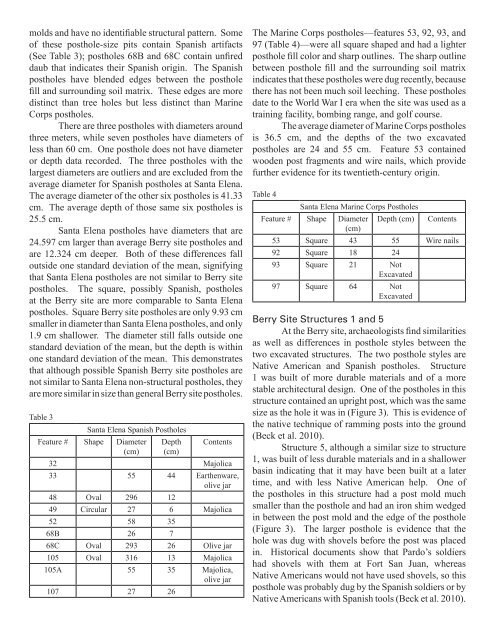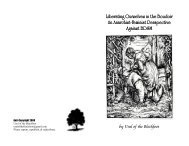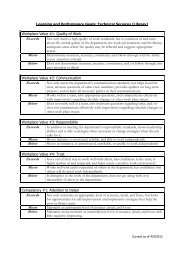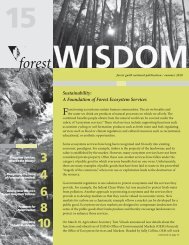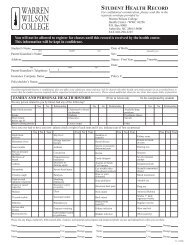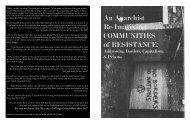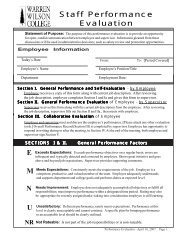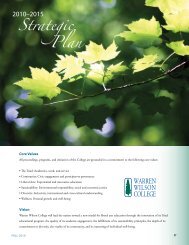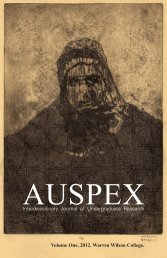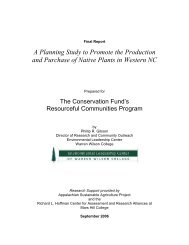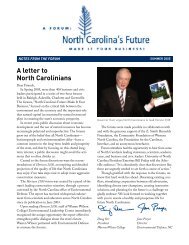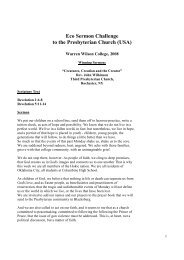Native American and Spanish Ancillary Structures - Warren Wilson ...
Native American and Spanish Ancillary Structures - Warren Wilson ...
Native American and Spanish Ancillary Structures - Warren Wilson ...
You also want an ePaper? Increase the reach of your titles
YUMPU automatically turns print PDFs into web optimized ePapers that Google loves.
molds <strong>and</strong> have no identifiable structural pattern. Some<br />
of these posthole-size pits contain <strong>Spanish</strong> artifacts<br />
(See Table 3); postholes 68B <strong>and</strong> 68C contain unfired<br />
daub that indicates their <strong>Spanish</strong> origin. The <strong>Spanish</strong><br />
postholes have blended edges between the posthole<br />
fill <strong>and</strong> surrounding soil matrix. These edges are more<br />
distinct than tree holes but less distinct than Marine<br />
Corps postholes.<br />
There are three postholes with diameters around<br />
three meters, while seven postholes have diameters of<br />
less than 60 cm. One posthole does not have diameter<br />
or depth data recorded. The three postholes with the<br />
largest diameters are outliers <strong>and</strong> are excluded from the<br />
average diameter for <strong>Spanish</strong> postholes at Santa Elena.<br />
The average diameter of the other six postholes is 41.33<br />
cm. The average depth of those same six postholes is<br />
25.5 cm.<br />
Santa Elena postholes have diameters that are<br />
24.597 cm larger than average Berry site postholes <strong>and</strong><br />
are 12.324 cm deeper. Both of these differences fall<br />
outside one st<strong>and</strong>ard deviation of the mean, signifying<br />
that Santa Elena postholes are not similar to Berry site<br />
postholes. The square, possibly <strong>Spanish</strong>, postholes<br />
at the Berry site are more comparable to Santa Elena<br />
postholes. Square Berry site postholes are only 9.93 cm<br />
smaller in diameter than Santa Elena postholes, <strong>and</strong> only<br />
1.9 cm shallower. The diameter still falls outside one<br />
st<strong>and</strong>ard deviation of the mean, but the depth is within<br />
one st<strong>and</strong>ard deviation of the mean. This demonstrates<br />
that although possible <strong>Spanish</strong> Berry site postholes are<br />
not similar to Santa Elena non-structural postholes, they<br />
are more similar in size than general Berry site postholes.<br />
Table 3<br />
Santa Elena <strong>Spanish</strong> Postholes<br />
Feature # Shape Diameter<br />
(cm)<br />
Depth<br />
(cm)<br />
Contents<br />
32 Majolica<br />
33 55 44 Earthenware,<br />
olive jar<br />
48 Oval 296 12<br />
49 Circular 27 6 Majolica<br />
52 58 35<br />
68B 26 7<br />
68C Oval 293 26 Olive jar<br />
105 Oval 316 13 Majolica<br />
105A 55 35 Majolica,<br />
olive jar<br />
107 27 26<br />
The Marine Corps postholes—features 53, 92, 93, <strong>and</strong><br />
97 (Table 4)—were all square shaped <strong>and</strong> had a lighter<br />
posthole fill color <strong>and</strong> sharp outlines. The sharp outline<br />
between posthole fill <strong>and</strong> the surrounding soil matrix<br />
indicates that these postholes were dug recently, because<br />
there has not been much soil leeching. These postholes<br />
date to the World War I era when the site was used as a<br />
training facility, bombing range, <strong>and</strong> golf course.<br />
The average diameter of Marine Corps postholes<br />
is 36.5 cm, <strong>and</strong> the depths of the two excavated<br />
postholes are 24 <strong>and</strong> 55 cm. Feature 53 contained<br />
wooden post fragments <strong>and</strong> wire nails, which provide<br />
further evidence for its twentieth-century origin.<br />
Table 4<br />
Santa Elena Marine Corps Postholes<br />
Feature # Shape Diameter<br />
(cm)<br />
Depth (cm) Contents<br />
53 Square 43 55 Wire nails<br />
92 Square 18 24<br />
93 Square 21 Not<br />
Excavated<br />
97 Square 64 Not<br />
Excavated<br />
Berry Site <strong>Structures</strong> 1 <strong>and</strong> 5<br />
At the Berry site, archaeologists find similarities<br />
as well as differences in posthole styles between the<br />
two excavated structures. The two posthole styles are<br />
<strong>Native</strong> <strong>American</strong> <strong>and</strong> <strong>Spanish</strong> postholes. Structure<br />
1 was built of more durable materials <strong>and</strong> of a more<br />
stable architectural design. One of the postholes in this<br />
structure contained an upright post, which was the same<br />
size as the hole it was in (Figure 3). This is evidence of<br />
the native technique of ramming posts into the ground<br />
(Beck et al. 2010).<br />
Structure 5, although a similar size to structure<br />
1, was built of less durable materials <strong>and</strong> in a shallower<br />
basin indicating that it may have been built at a later<br />
time, <strong>and</strong> with less <strong>Native</strong> <strong>American</strong> help. One of<br />
the postholes in this structure had a post mold much<br />
smaller than the posthole <strong>and</strong> had an iron shim wedged<br />
in between the post mold <strong>and</strong> the edge of the posthole<br />
(Figure 3). The larger posthole is evidence that the<br />
hole was dug with shovels before the post was placed<br />
in. Historical documents show that Pardo’s soldiers<br />
had shovels with them at Fort San Juan, whereas<br />
<strong>Native</strong> <strong>American</strong>s would not have used shovels, so this<br />
posthole was probably dug by the <strong>Spanish</strong> soldiers or by<br />
<strong>Native</strong> <strong>American</strong>s with <strong>Spanish</strong> tools (Beck et al. 2010).


